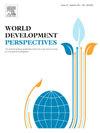凯恩斯流动性偏好理论与非洲小额信贷银行
IF 2.3
Q2 DEVELOPMENT STUDIES
引用次数: 0
摘要
凯恩斯主义和后凯恩斯主义经济学家对流动性偏好理论和从传统银行获得贷款资金的重要性进行了广泛的讨论。然而,在作为发展中国家重要金融机构的小额信贷银行(mfb)领域内,明显缺乏理论和经验证据来证明凯恩斯的金融动机在刺激货币需求和促进经济增长方面的有效性。本文试图通过检查凯恩斯(1936)金融循环的修改版本,凯恩斯(1936)的货币需求和经济增长模型,其中包括来自mfb的资金,来解决当前的研究差距。本文旨在利用1990年至2021年期间32个非洲国家的样本,通过对上述理论贡献的重要性进行实证评估,进一步为文献做出贡献。我们在异质面板中使用格兰杰因果检验,以及固定效应普通最小二乘法,平均群法和广义矩法。实证结果证实了在金融体系中纳入小额信贷银行资金的重要性,它降低了利率,提高了货币需求和经济增长,正如我们的理论贡献所说明的那样。政策影响表明,监管当局必须让小额信贷银行参与金融体系并降低利率。这一策略可能会增加货币需求,促进经济增长。本文章由计算机程序翻译,如有差异,请以英文原文为准。
Keynes’ theory of liquidity preference and microfinance banks in Africa
Keynesian and Post Keynesian Economists have extensively discussed the theory of liquidity preference and the importance of obtaining loan funds from traditional banks. However, there is a distinct lack of theoretical and empirical evidence that demonstrates the effectiveness of Keynes’ Finance Motive in stimulating the demand for money and fostering economic growth within the realm of microfinance banks (MFBs) as vital financial institutions in developing countries. This paper endeavors to address the current research gap by examining a modified version of Keynes’ (1936) Finance Circuit, Keynes’ (1936) money demand and economic growth models that incorporates funds from MFBs. The present paper aims to further contribute to the literature through the empirical assessment of the significance of the above theoretical contributions using a sample of 32 African countries covering the time frame from 1990 to 2021. We utilize Granger causality tests in heterogeneous panels, as well as the Fixed Effect Ordinary Least Squares method, the Mean Group Method, and the Generalized Method of Moments. The empirical results confirm the significance of the inclusion of microfinance bank funds in the financial system which lower interest rates and enhance the demand for money and economic growth as illustrated in our theoretical contributions. The policy implications indicate that it is fundamental for regulatory authorities to involve microfinance banks in the financial system and to lower interest rates. This strategy is likely to enhance the demand for money and promote economic growth.
求助全文
通过发布文献求助,成功后即可免费获取论文全文。
去求助
来源期刊

World Development Perspectives
Social Sciences-Sociology and Political Science
CiteScore
4.50
自引率
0.00%
发文量
65
审稿时长
84 days
期刊介绍:
World Development Perspectives is a multi-disciplinary journal of international development. It seeks to explore ways of improving human well-being by examining the performance and impact of interventions designed to address issues related to: poverty alleviation, public health and malnutrition, agricultural production, natural resource governance, globalization and transnational processes, technological progress, gender and social discrimination, and participation in economic and political life. Above all, we are particularly interested in the role of historical, legal, social, economic, political, biophysical, and/or ecological contexts in shaping development processes and outcomes.
 求助内容:
求助内容: 应助结果提醒方式:
应助结果提醒方式:


